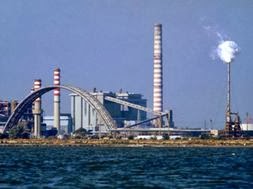Plastic secrets and lies
 |
| The PVC plant, owned first by Montedison and then EniChem at Porto Marghera, Venice. |
Rather than make this information public, Italian chemical giant Montedison joined with other European manufacturers and US companies, including Dow Chemical and Union Carbide, to make a secret pact to trade health information about vinyl chloride. They signed a secrecy agreement forbidding the disclosure of their research findings. (Plastic companies got into collusive agreements on price in the '80s too.)
"All international companies, including the Italian conglomerate Montedison, signed a pact of secrecy about the proof (of) PVC (being) carcinogenic," says prosecutor Felice Casson, in Werner Boote's 2009 film, Plastic Planet. "Therefore all studies regarding these materials (were) kept classified. Whoever (got) hold of this information was bound to secrecy and had to sign the ... ‘secret contract’ which we eventually found and presented in court."
Despite US PVC manufacturer, BF Goodrich, sending out a press release about PVC deaths at their plant in 1974, at the Italian company, it was business as usual. They dismissed concerns, claiming the proof was inconclusive; tests had been carried out on animals, not humans.
 |
Gabriele Bortolozzo, with his daughter, Beatrice,
who carried on his fight after Gabriele's death.
|
Bortolozzo retired in 1990 but continued his tireless evidence gathering. With added environmental research from Greenpeace, he approached crack prosecutor, (now Italian Senator) Felice Casson in 1994. Casson had uncovered terrorist networks, dealt with drug dealers, even exposed a NATO stay-behind paramilitary force. Big Petrochem didn't scare him.
 |
| Felice Casson, now an Italian Senator |
In 1996, 31 former executives of Montedison and EniChem stood trial for manslaughter "with foresight" of over 150 workers at the plant; for ignoring warnings and allowing their employees to breathe extremely high amounts of vinyl chloride and its relative, ethylene dichloride, inside the plant at Porto Marghera. Another 600 or so workers were believed to be suffering from work-related illnesses. The companies were also charged with polluting Venice Lagoon: "The bottom sediment is like a slimy, black tar," Greenpeace organiser Fabrizio Fabbri said at the time.

In 1998, the companies tried to settle out of court, but Gabriele Bortolozzo's children, Gianluca and Beatrice, refused. They (and some others) carried on with the court case in honour of their father. In late May, most of the 500 or so individual plaintiffs in the case - sick workers and relatives of those who had died - accepted a $36.5 million settlement offer from the two companies.
In 2001 the managers of the
incriminated companies were absolved on the grounds that, at the time of
contamination, negligence in PVC was not a legal offence, in spite of the fact
that 546 workers had suffered diseases, of whom some 200 had tumours.
On appeal in
2004, however, judges pronounced some of the
managers guilty. Five received a suspended sentence. But the rest were set free due to the
lapse of time.
It's ten years later. Do such pacts of secrecy still go on today? Is research still covered up? Do our governments protect us against such corporate crimes of indifference, greed and brutality? Does it make sense that just about 100% of industry-backed research shows virtually no harm of BPA and phthalates, whereas non-industry research tends to suggest otherwise?
 |
Injustice for Venice - Greenpeace protestors
hold a silent vigil after the court.
|
It's ten years later. Do such pacts of secrecy still go on today? Is research still covered up? Do our governments protect us against such corporate crimes of indifference, greed and brutality? Does it make sense that just about 100% of industry-backed research shows virtually no harm of BPA and phthalates, whereas non-industry research tends to suggest otherwise?
Further reading
- http://en.wikipedia.org/wiki/Vinyl_chloride#Health_effects
- http://www.greenpeace.org/international/en/campaigns/toxics/polyvinyl-chloride/the-poison-plastic/
- http://www.greenpeace.org/international/en/press/releases/pvc-managers-get-away-with-man/
- http://agb.provincia.venezia.it/RaStampa/StampaEstera/Usa/HoustonChronicle.html
- http://ottantuno.wordpress.com/2012/06/07/le-due-verita-di-brindisi-e-marghera-cosi-il-mal-damianto-spacca-le-procure/ (in Italian)
- Plastic Planet, by Werner Boote (film)
- The Gabriele Bortolozzo Association (in Italian)
- http://www.ejolt.org/wordpress/wp-content/uploads/2013/10/131007_EJOLT09-final-Low-resolution.pdf
- http://www.alexanderlanger.org/en/108
- http://www.gelmans.com/ReadingRoom/tabid/65/ctl/ArticleView/mid/372/articleId/446/Vinyl-Chloride-Conspiracy-Documents-Part-3-Jan-1974--May-1974.aspx

Comments
Post a Comment